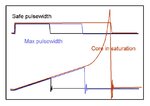iliya24
Member level 2
Hello i need to choose a coil or high current application and i read some articles about it and i saw 2 importan things 1)HEAT RATING CURRENT DC AMPS
2)SATURATION CURRENT DC AMPS can u help me to understand the meaning and the difference.
Thx.
2)SATURATION CURRENT DC AMPS can u help me to understand the meaning and the difference.
Thx.
